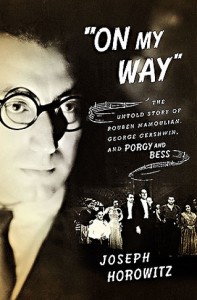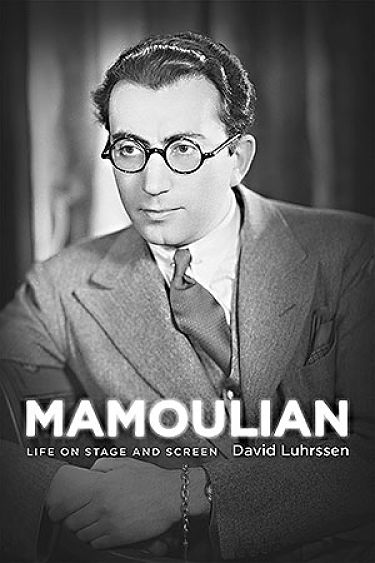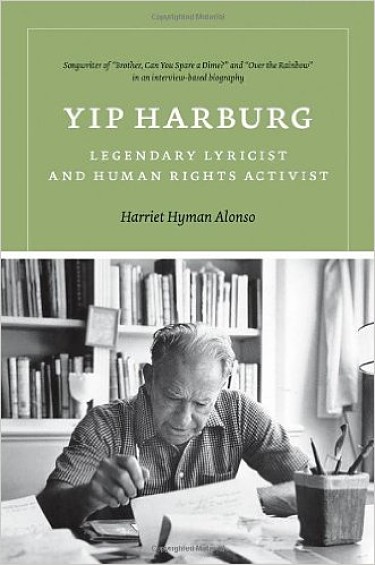“While all entertainment is not art, all art is entertainment.” That was stage and film director Rouben Mamoulian’s pronouncement in a 1935 radio interview, the same year he helmed the world premiere of George Gershwin’s folk opera Porgy and Bess on Broadway. It’s also the mindset that links this quartet of recent books about musical theatre. All four portray serious artists at work in the commercial arena, driven as much by a need to create something meaningful and lasting as by the bottom line of putting butts in seats. Cumulatively, they cast quite the shadow across today’s Great White Way.

Former New York Times music critic Joseph Horowitz ingeniously melds biography with critical study in On My Way. The book was born out of his “educated guess” that director Rouben Mamoulian must have shaped Porgy and Bess much more than was commonly thought, and the proof lay waiting for him in the Mamoulian archives at the Library of Congress, which were not opened until 2009. There he found Mamoulian’s script for Porgy, the 1927 play adaptation of DuBose Heyward’s 1925 novel of the same name, which launched the Armenian émigré’s directing career. Heyward’s wife, Dorothy, did the initial adaptation without telling her husband what she was up to. Once he knew, he joined forces with her on the script.
Mamoulian’s copy, however, did not match the play’s published version, and it was soon clear how much the director had brought to the production (which George Gershwin saw, and the rest is history). Among other things, Horowitz discovered the famous cry “Bring my goat!” penciled in by Mamoulian, as well as the addition of a traditional spiritual, “I’m on My Way,” with a lyric similar to the one that closes Porgy and Bess (though the melody is not, as Horowitz shows, in one of many helpful bits of musical notation that dot the book). This changed Porgy’s ending from downbeat to redemptive.
Horowitz elucidates the creation of both play and opera in riveting detail, and he writes compellingly of the sad coda, when, in a fit of “No head shall be higher than the king’s,” producer Sam Goldwyn fired Mamoulian as director of the film of Porgy and Bess, just prior to the start of shooting in the summer of 1958, after many months of preproduction work on Mamoulian’s part. Along the way Horowitz also discusses Mamoulian’s Hollywood career, especially his groundbreaking musicals Applause (1929) and Love Me Tonight (1932), and he covers the director’s important Broadway work, particularly his collaborations with Rodgers and Hammerstein on two landmark musicals, Oklahoma! (1943) and Carousel (1945). But the heart of the book is in its subtitle, and Horowitz’s sleuthing and analytical acumen make On My Way an unmissable read for anyone serious about American musical theatre.

Clocking in at a mere 208 pages, David Luhrssen’s Mamoulian: Life on Stage and Screen can sometimes feel a bit perfunctory. (The only other bio, Mark Spergel’s 1993 effort Reinventing Reality: The Art and Life of Rouben Mamoulian, runs nearly double that.) Still, it’s a useful companion to Horowitz’s book, filling in the gaps and making it clear what a revolutionary artist Mamoulian was in his relentless search for what Richard Wagner termed Gesamtkunstwerk, the highly stylized fusion of music, drama, dance and design into a total theatre.
Luhrssen is especially successful in his recounting of Mamoulian’s groundbreaking early movies, made during the dawn of sound. Whether freeing the camera to move in Applause, examining sexual repression in Dr. Jekyll and Mr. Hyde (1931), or experimenting with nascent Technicolor in Becky Sharp (1935), Mamoulian innovated and turned a profit. He also worked with an astonishing array of talent. In addition to Heyward, the Gershwins and R&H, there were Eugene O’Neill, Kurt Weill, Maxwell Anderson, Harold Arlen, Johnny Mercer, Vernon Duke, Howard Dietz, Jerome Kern, Cole Porter and Dorothy Fields writing the scripts and scores, and Greta Garbo, Marlene Dietrich, Helen Morgan, Fredric March, Sylvia Sidney, Miriam Hopkins, Jeanette MacDonald, Maurice Chevalier, Myrna Loy, Barbara Stanwyck, William Holden, Tyrone Power, Walter Huston, Mickey Rooney, Irene Dunne and Fred Astaire starring in the films.
Curiously, although both books are filled with personal information—how he dressed and spoke, his likes and dislikes, even accounts of how he behaved in rehearsal—neither quite locates the private man. Formal and courtly, unless in the midst of a fit of high-handedness or artistic grandiloquence, Mamoulian moves through the world at a remove. His career came to a sad halt after back-to-back firings from high-profile film projects—Porgy and Bess and the Elizabeth Taylor Cleopatra—and he lived out his remaining two decades in Beverly Hills with his wife and cats. His best films are largely unknown today, and his stage work was, of course, ephemeral. His importance to the performing arts in the 20th century, however, cannot be underestimated.

Though his name may not be any more recognizable to the general public today than Mamoulian’s, book writer and lyricist E.Y. “Yip” Harburg can lay his own claim to iconic status, if only for his involvement as lyricist and co-conceiver of the 1939 MGM musical The Wizard of Oz. As Harriet Hyman Alonso’s biography hints at in its subtitle, the idée fixe of the man who wrote the words for the protest song “Brother, Can You Spare a Dime” was his socialist-tinged politics, which got him blacklisted in Hollywood, despite his never having been a Communist. Unlike Mamoulian, Harburg the man comes roaring through in this “interview-based” work; indeed, he almost never shuts up. Alonso quotes far too liberally from numerous interviews, lectures and oral histories, almost all of them conducted in the later years of Harburg’s life, after his theatrical career had essentially ended. While his passion and intelligence are always in evidence, Harburg rambles a great deal, and Alonso’s injudicious editing has him repeating himself far too often. It’s also clear that he’s more than a bit of a fabulist, refashioning history to suit his own ends.
When we hear about the creation of such Broadway hits as Finian’s Rainbow and Bloomer Girl, Alonso’s uncritical, almost adulatory approach leaves us wondering what we’re not being told. Nor does she add to her credibility by refusing to recognize Harburg’s shortcomings as a dramatist—at lyrics he was peerless—when discussing flops such as Flahooley and The Happiest Girl in the World. What she’s best at is shining a light on Harburg’s political humanism. It may not always have served him well dramaturgically, but Harburg’s deep need to incorporate his concern for his fellow man in his work is as admirable as it is moving.

Fiddler on the Roof is as political a piece of art as anything Harburg created, yet the show is careful not to wave it like a banner. Director/choreographer Jerome Robbins signed on to the project—an adaptation of Sholem Aleichem’s short stories about Tevye, a Jewish milkman toiling in a shtetl in czarist Russia to provide for his wife and seven daughters—because he was determined to recreate for audiences a vanished world undone by Russian oppression, forced emigration and cultural assimilation, and, finally, the Holocaust. Alisa Solomon’s terrific Wonder of Wonders examines the “cultural history” of this beloved musical, making a persuasive case that Robbins and his collaborators—book writer Joseph Stein, composer Jerry Bock and lyricist Sheldon Harnick—achieved their goal beyond their grandest ambitions.
Solomon begins with Sholem Aleichem himself, recounting his work as a playwright in the Yiddish theatre, his desire to succeed on the New York stage and his creation of Tevye. She clearly situates the source material in American society—generational shifts regarding the desire to assimilate, shame about the Yiddish language, the persistence of anti-Semitism in a changing America—at the time of the musical’s creation. If her account owes a debt to The Making of a Musical, written by Robbins’s assistant director Richard Altman with Mervyn Kaufman in 1971, seven years after Fiddler’s Broadway debut, she has also done her own research and admirably doesn’t accept Altman unquestioningly.
Where Solomon’s book soars, however, is in its second half, when she examines the show’s effect across the globe, beginning with its production in Israel—the first one after Broadway—and continuing through a controversial 1968 high school production in Brooklyn that is complicated by racial animosity between Jews and blacks, on up to a 2006 site-specific mash-up of Fiddler songs and an adapted script in Dynów, Poland, in the shadow of Auschwitz. The extent of the show’s worldwide influence is incisively and unsentimentally portrayed. As Mrs. Higgins, the mother of the hero of another culturally indelible musical, might put it: Bravo, Alisa!
Erik Haagensen is the former theatre editor and head critic of Backstage and an award-winning playwright/lyricist.


